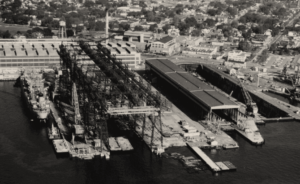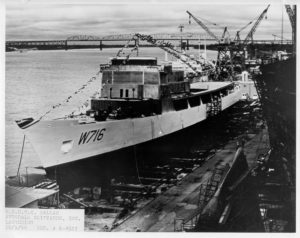Shipyard workers are especially at risk of mesothelioma and other asbestos-related diseases. This is because they worked with asbestos-containing ship parts like insulation, pipes, and boilers throughout the 20th century. Get help now if you or a loved one was a shipyard worker and now has mesothelioma.
Mesothelioma and Shipyard Workers Explained
Shipyard workers are among those at the highest risk of mesothelioma. This is because countless vessels — including almost every U.S. Navy ship — relied on asbestos, the only known cause of this cancer, for nearly 50 years.
Shipyard workers exposed to asbestos materials 10-50 years ago are in danger of mesothelioma and other asbestos-related diseases today.
The New York Times reported that nearly 4.5 million shipyard workers suffered significant exposure to asbestos during World War II alone.
Thankfully, help is available for shipyard workers and anyone else now fighting mesothelioma. Learn about all the benefits you may qualify for in our Free Veterans Packet.
Why Was Asbestos Used in Shipyards?
The shipbuilding industry relied on asbestos since it was lightweight, fire-resistant, and a great insulator. Further, though makers of asbestos-based products knew asbestos was harmful back in the 1930s, they hid the dangers to keep making money.
The shipyard industry used about 197 million pounds of asbestos in the early 1930s. This number escalated to about 633 million pounds of asbestos by 1937. Asbestos was still used by shipbuilders until the late 1970s.
The health risks of asbestos were particularly high among shipyard workers who served in the U.S. Navy. This is because government mandates required all Navy vessels to use asbestos for decades. Many Coast Guard vessels were also built with asbestos.
As a result of this widespread asbestos use, 33% of mesothelioma patients served in the U.S. Navy or worked in shipyards.
Asbestos Products Used by Shipyard Workers
Over 300 different asbestos-containing products were used to build Navy ships between the 1940s and mid-1980s.
As shipyard workers installed, repaired, or removed these asbestos-containing components, fibers could be released into the air. Those nearby could breathe in or swallow the fibers and develop mesothelioma 10-50 years later.
Some of the most notable products included:
- Adhesives
- Boilers
- Cables
- Cement
- Deck coverings
- Electrical components
- Gaskets
- Grinders
- Insulation
- Paint
- Pipes and pipe coverings
- Tape
- Tubes
- Valves
Chrysotile asbestos was used in gaskets, packing, tape, and insulation on vessels, while amosite asbestos was primarily used for insulating ships and submarines.
Further, U.S. Supreme Court filings revealed that miles of Navy ship piping and cable, as well as hundreds of valves, relied on asbestos.
Do you have mesothelioma after serving in a shipyard? Contact us now to get help finding medical treatment, military benefits, and financial aid.
Highest-Risk Jobs for Asbestos Shipyard Workers


Working on ship insulation released asbestos fibers into the air that workers could inhale.
Other shipyard jobs with a high risk of asbestos exposure included:
- Boilermakers
- Electricians
- Machinists
- Painters
- Pipefitters
Any military service member or civilian who served in these roles at a shipyard could have been exposed to asbestos on a daily basis.
That said, all shipyard workers were at risk of asbestos exposure. A 1979 report from the New York Times stated that asbestos dust clouded World War II-era shipyards so that workers couldn't even see across the rooms they worked in.
This exposure had long-term consequences. In the late 1970s, a study found that 4 out of 5 workers at the Bethlehem Steel shipyard in Baltimore, Maryland, had lung damage linked to asbestos. Many more shipyard workers have gone on to develop mesothelioma and other asbestos-related diseases since that time.
Benefits for Shipyard Workers With Mesothelioma
Former shipyard workers who contracted mesothelioma or another asbestos-related disease may be able to get help.
Veterans with mesothelioma, including those who were shipyard workers, can receive benefits from the U.S. Department of Veterans Affairs (VA). Private compensation may also be available to both military and civilian shipyard workers.
VA Benefits for Asbestos Shipyard WorkersIf you're a shipyard worker who served in the military and now have mesothelioma, your service entitles you to benefits from the VA.
The VA has some of the best mesothelioma doctors in the world and has programs in place to help pay for travel and treatment-related expenses. You likely also qualify for monthly disability compensation, which is usually worth $3,823.89 per month as of 2023.
We can help you file for mesothelioma VA benefits now.
Private Compensation for Shipyard WorkersShipyard workers who developed mesothelioma may be able to hold makers of asbestos-based products accountable through private claims. Remember: manufacturers hid the risks of asbestos for decades.
The average private claim (also known as a mesothelioma lawsuit) awards $1 million or more. You could also start seeing money from a settlement in as little as 90 days.
We can help you find a mesothelioma lawyer to file a private claim.
Mesothelioma and Shipyard Workers: Get Help Now
Mesothelioma in shipyard workers remains an all-too-prevalent health problem. Thousands of people have tragically been diagnosed and passed away from this cancer simply from doing their job.
The Mesothelioma Veterans Center can help military and civilian shipyard workers in their battle with cancer. Our team has connections with top doctors so you can get the best treatments faster.
Further, our team can help you file for VA benefits and private compensation, so you won't have to worry financially after a diagnosis.
See all the ways we can help you in our Free Veterans Packet.
Mesothelioma and Shipyard Workers FAQs
Are shipyard workers exposed to asbestos?
Yes. Up through the late 1970s and early 1980s, shipyards across the country relied on asbestos.
Asbestos was commonly used in shipbuilding to make products like insulation, wiring, and piping more durable.
Unfortunately, exposure to asbestos in shipyards put workers at a high risk of mesothelioma later in life.
What are the dangers of working in a shipyard with asbestos?
Shipyard workers exposed to asbestos could go on to develop mesothelioma or other severe illnesses like lung cancer or asbestosis 10-50 years later.
This is because asbestos fibers are carcinogenic (cancer-causing) and shipyard workers used products containing this substance on a daily basis.
Can you sue for working around asbestos in shipyards?
Possibly, yes. You may qualify to file a lawsuit if you got sick with mesothelioma or another asbestos-related disease after working in a shipyard.
You won't sue your former employer or the U.S. military. Instead, your case will be filed against companies that made and sold asbestos-containing products.


